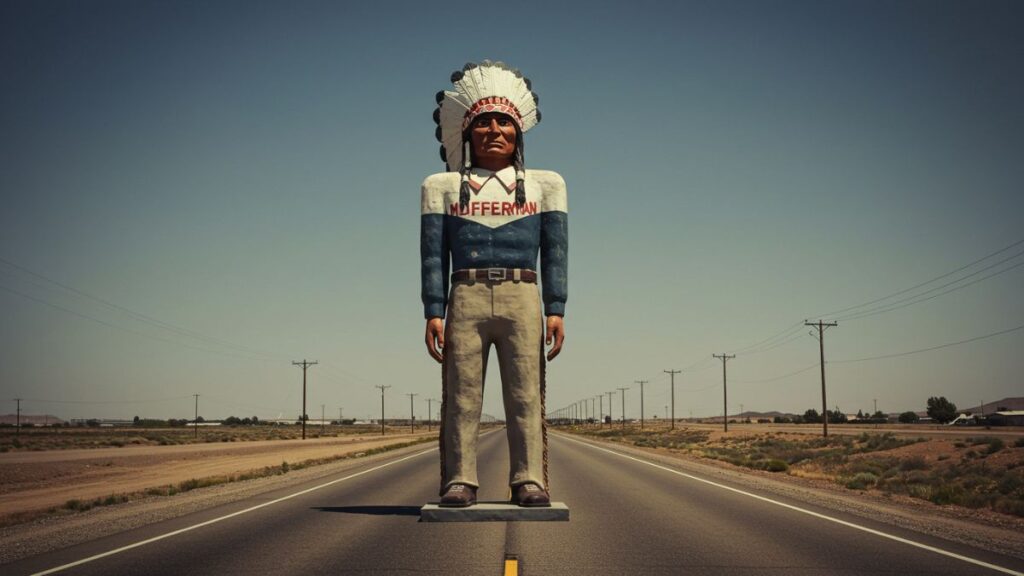What Is the Muffler Man?
The Muffler Man refers to a series of giant fiberglass statues originally created as roadside advertising figures in the United States. These towering icons, standing anywhere from 18 to 25 feet tall, became a hallmark of mid-20th-century Americana. Often holding mufflers, tires, tools, or other symbols, these figures were used to attract drivers’ attention to local businesses like auto repair shops, diners, gas stations, and other roadside attractions.
The name “Muffler Man” comes from one of the most common iterations: a statue holding a car muffler in his massive hands. While not all of them were muffler-bearing giants, the name stuck as a collective term for these statues.
These statues are more than just advertising gimmicks; they represent a nostalgic era in American culture when road trips were king, and businesses did whatever they could to stand out on the roadside.
The Origin of the Muffler Man
The story of the Muffler Man begins in the 1960s with International Fiberglass, a company based in Venice, California. Owner Steve Dashew purchased the business and began mass-producing giant fiberglass figures based on an original Paul Bunyan statue. The first was commissioned for the Paul Bunyan Café on Route 66 in Flagstaff, Arizona.
Once the mold existed, the possibilities were endless. By simply changing the figure’s props, color scheme, and slight physical alterations, the same mold could be repurposed for dozens of businesses across the country. From there, the Muffler Man legend took off.
Although International Fiberglass closed in the late 1970s, hundreds of these statues were produced and many still stand today, maintained by businesses, collectors, or preservationists who understand their nostalgic and cultural value.
Different Types of Muffler Men
Though they are commonly referred to by a single name, Muffler Men come in various types and styles. Each variation reflects the creativity of the business or region where the figure was installed.
Classic Muffler Man
This version is the most iconic—a clean-cut giant with neatly combed hair, holding a muffler or tire. He typically wears a work shirt and pants and can still be found outside automotive shops.
Paul Bunyan
The original Muffler Man mold, with an ax-wielding lumberjack appearance. Often used by logging companies, diners, or businesses wanting a rugged, Americana vibe.
Cowboy
With cowboy hats, boots, and sometimes lassos, these figures stood tall outside Western-themed businesses or in Southwest towns.
Native American
Less common today and controversial due to their cultural representation, these statues were used for trading posts or souvenir shops.
Viking
Featuring horned helmets and weaponry, Viking Muffler Men were a popular adaptation in Northern states or for fantasy-themed attractions.
Pirates, Golfers, and Custom Figures
Some Muffler Men were altered into completely new figures such as pirates, golfers, or spacemen. The base mold remained the same, but extensive customization created unique versions tailored to the location’s business theme.
If you want to read more, visit our blog page. We have more topics!
Why the Muffler Man Became a Roadside Icon
The rise of the Muffler Man coincided with the golden age of American road trips. The Interstate Highway System was expanding, and Americans were hitting the open road in unprecedented numbers. Roadside attractions became big business, and companies looked for larger-than-life ways to capture attention.
The Muffler Man provided the perfect solution: he was tall, noticeable from a distance, and could be customized to fit almost any business. Kids were amazed, adults took pictures, and the statues became landmarks in their own right.
The fiberglass construction made them relatively inexpensive to manufacture and easy to transport, allowing small businesses to invest in giant advertising without the cost of a billboard campaign.
Over time, these statues became cultural touchstones. People gave them nicknames, told stories about them, and made them waypoints during family road trips. They bridged the gap between kitsch and art, advertising and Americana.
The Decline and Revival of the Muffler Man
With the closure of International Fiberglass in the late 1970s, production of new Muffler Men ceased. Many were removed, damaged, or forgotten. As tastes in advertising evolved, and businesses leaned more toward modern and minimalist branding, the giant fiberglass statues began to disappear.
However, in the 1990s and 2000s, a revival began. The rise of internet culture and the growing appreciation for vintage Americana led collectors and preservationists to seek out and restore surviving Muffler Men. Websites, social media pages, and travel blogs dedicated to documenting these statues brought them back into the public eye.
Organizations and individuals across the country began repairing faded paint jobs, fixing broken limbs, and restoring these giants to their former glory. Some even relocated them to new homes where they could continue standing tall and delighting passersby.
Where to Find Muffler Men Today
Though fewer than during their peak, many Muffler Men still stand tall across the United States. Here are some of the most famous and beloved locations:
-
Atlanta, Illinois: A classic Muffler Man dressed as Paul Bunyan holding a hot dog, known as the “Hot Dog Muffler Man.”
-
Ventura, California: One of the original Paul Bunyan statues from the 1960s still greets visitors with his massive ax.
-
Springfield, Illinois: A cowboy version stands outside a local western wear shop.
-
Lauterbach Tire in Springfield: Another well-maintained example with a painted uniform and a tire in hand.
-
Gallup, New Mexico: A Native American-style figure stands outside a trading post.
-
Lake George, New York: A unique pirate version guards a miniature golf course.
Travelers often plan road trips around Muffler Men sightings, and there are interactive maps online that chart their locations nationwide.
Cultural Impact of the Muffler Man
The Muffler Man is more than just a roadside statue—it’s a symbol of an era in American life characterized by freedom, open roads, and quirky marketing. These giants have appeared in films, TV shows, music videos, and books. They’ve been referenced by artists and admired by cultural historians.
As America becomes increasingly urbanized and commercialized, the Muffler Man represents a fading but cherished sense of individuality and whimsy. He evokes a time when businesses competed with creativity and flair rather than flashy websites and algorithms.
The Muffler Man also serves as a reminder of how advertising has evolved. Where once a business relied on a 20-foot-tall man to bring in customers, now it turns to search engines and social media. Yet the Muffler Man remains standing—silent but expressive, nostalgic yet timeless.
Have you found this topic useful? For more informative content, check out the rest of our blog!
How to Preserve Muffler Men for the Future
Preserving Muffler Men involves a mix of community effort, historical awareness, and sheer passion. Restoration can be expensive, but many towns and businesses have found the investment worthwhile due to the attention and tourism these giants attract.
Here are some ways communities and individuals help preserve them:
-
Restoration Projects: Volunteers repaint and repair aging statues.
-
Fundraisers: Local businesses and organizations raise money to restore or transport Muffler Men.
-
Historical Registrations: Some are added to local or state historic registers.
-
Relocation: When a business closes, some Muffler Men are moved to museums, parks, or other public places.
Collectors also play a vital role, often purchasing deteriorating figures and restoring them for display on private properties or public exhibits.
Muffler Man in Pop Culture
These fiberglass giants have made their way into popular culture over the years. They’ve appeared in:
-
TV shows like American Pickers, which has featured searches for rare Muffler Men
-
Movies such as Pee-wee’s Big Adventure and various road-trip films
-
Comics and graphic novels that include surreal or nostalgic Americana themes
-
Social media and TikTok, where they’ve found new audiences among travel influencers and nostalgia lovers
Their lasting appeal lies in their kitschy charm and timeless status as American icons.
Conclusion
The Muffler Man remains one of the most memorable symbols of American roadside culture. Standing tall at intersections, beside tire shops, and outside retro diners, these fiberglass giants tell stories of a different time—when travel was an adventure, and a business could grab your attention with nothing more than a massive man holding a muffler.
Today, thanks to dedicated fans, communities, and preservationists, Muffler Men are still standing, still smiling, and still reminding us of the bold creativity that once lined America’s highways. Whether you’re a road trip junkie, a history buff, or just a lover of the quirky and offbeat, the Muffler Man is a cultural treasure worth visiting.
FAQs
What is a Muffler Man?
A Muffler Man is a giant fiberglass statue originally used for roadside advertising, often standing between 18 and 25 feet tall.
How many Muffler Men are there in the U.S.?
There are believed to be around 200 Muffler Men still standing today, though the exact number changes due to restorations and discoveries.
Who made the original Muffler Man?
International Fiberglass in Venice, California, created the original Muffler Man statues in the 1960s.
Are there different types of Muffler Men?
Yes, including Paul Bunyan, cowboys, Native Americans, vikings, and custom versions like pirates or golfers.
Why are Muffler Men important?
They represent a unique period in American advertising and roadside culture, serving as nostalgic icons of mid-century life.
Can you visit Muffler Men today?
Yes, many are still on public display across the country, often marked on roadside attraction maps.
Do Muffler Men all look the same?
While most share a common mold, their paint, props, and slight modifications make each one unique.
How can I help preserve a Muffler Man?
Support local restoration projects, donate to preservation groups, or simply share photos and stories to keep the tradition alive.







